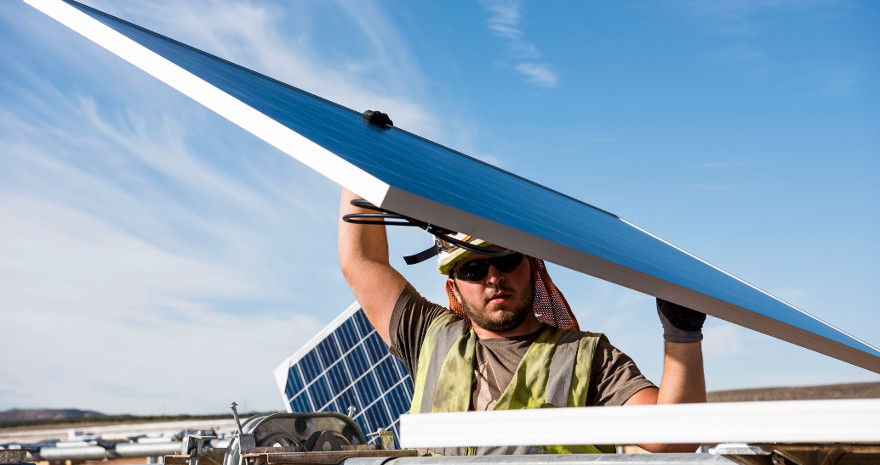Many claims have been made about the potential damage to the U.S. solar industry due to tariffs under Section 201. But while analysts and individual companies can point to data regarding the period of the investigation and lead-up to the tariffs, in many ways the results of the tariffs themselves – imposed only two months ago – are too recent to be reflected in official data.
Yesterday, Solar Energy Industries Association (SEIA) reported that it has heard from 18 companies that plan to reduce their deployment or workforce in 2018, as part of a filing generally supporting requests for exclusions from the Section 201 tariffs.
SEIA mentioned three individual companies, saying that one has reported that it is cancelling US$1.5 billion in planned investments, that another cancelled plans to hire hundreds of workers for large-scale projects, and that a third has cut 250 jobs and incurred more than $20 million in restructuring charges.
Multiple points of causation
These numbers line up with what pv magazine is seeing in the market; however as usual there are multiple points of causation that must be considered, in addition to the Section 201 tariffs.
The numbers for the final claim line up with SunPower’s February statement that it would lay off 150-250 workers, or 3% of its global workforce. It is important to note that while SunPower will be heavily affected by the Section 201 tariffs, given that it manufactures almost exclusively outside the United States, but deploys mostly within the nation’s borders, the company’s financial problems did not begin with Section 201.
SunPower has been losing large amounts of money every quarter for years, and had vowed to return to “sustainable profitability” by the second half of 2018, before the imposition of Section 201 tariffs.
SEIA has identified Cypress Creek as the company cancelling $1.5 billion in investment. And while tariffs are no doubt highly negative for the business of Cypress Creek and all other utility-scale developers, the company has also been developing a large number of projects under the Public Utilities Regulatory Policy Act of 1978 (PURPA) in newly emerging state markets. As such, Cypress Creek is particularly vulnerable to the many changes that have been made to state-level implementation of this policy.
Popular content
Context is important here. In contrast to SEIA’s statements, the latest edition of Solar Foundation’s National Solar Jobs Census expects a 5% increase in U.S. solar jobs by November 2018, after a dip last year caused largely by the “hangover” from the expected drop-down of the U.S. investment tax credit.
Additionally, there are multiple policy issues that could affect the U.S. solar market this year, including other tariffs imposed by the Trump Administration and tax reform, in addition to the usual slings and arrows of state-level policy changes.
No manufacturing renaissance
SEIA has also noted that the Section 201 tariffs have not fulfilled their stated aim of meaningfully increasing employment. “The domestic manufacturing response to import relief awarded in this case has been underwhelming and does not remotely resemble what the petitioners told the administration to expect,” states the letter by SEIA CEO, Abigail Ross Hopper.
To date, there have been only a handful of U.S. solar module manufacturing announcements following the injury finding by the U.S. International Trade Commission last fall. The largest of these, JinkoSolar’s plan for a new factory in Florida, will involve only 200 jobs. The sum total of new hires in module manufacturing is likely to number less than 1,000.
This is several orders of magnitude less than the 45,000 U.S. solar manufacturing jobs that Suniva and SolarWorld claimed that Section 201 tariffs could create, if a minimum 74¢/W price for foreign manufactured solar panels was implemented. And while the two companies’ requests for trade action were far more severe than what was finally issued by the Trump Administration, it is important to note that fulfilling such requests would likely have done far more near-term damage to the U.S. solar market.
Specifically, the trade proposals issued by the two companies would have done much greater harm to the portions of the existing U.S. solar industry involved in deployment and the much larger portion of employment they represent, for a minimum of several years – with up to 88,000 jobs projected as potentially being lost in the most aggressive of tariff implementations.
This content is protected by copyright and may not be reused. If you want to cooperate with us and would like to reuse some of our content, please contact: editors@pv-magazine.com.


1 comment
By submitting this form you agree to pv magazine using your data for the purposes of publishing your comment.
Your personal data will only be disclosed or otherwise transmitted to third parties for the purposes of spam filtering or if this is necessary for technical maintenance of the website. Any other transfer to third parties will not take place unless this is justified on the basis of applicable data protection regulations or if pv magazine is legally obliged to do so.
You may revoke this consent at any time with effect for the future, in which case your personal data will be deleted immediately. Otherwise, your data will be deleted if pv magazine has processed your request or the purpose of data storage is fulfilled.
Further information on data privacy can be found in our Data Protection Policy.